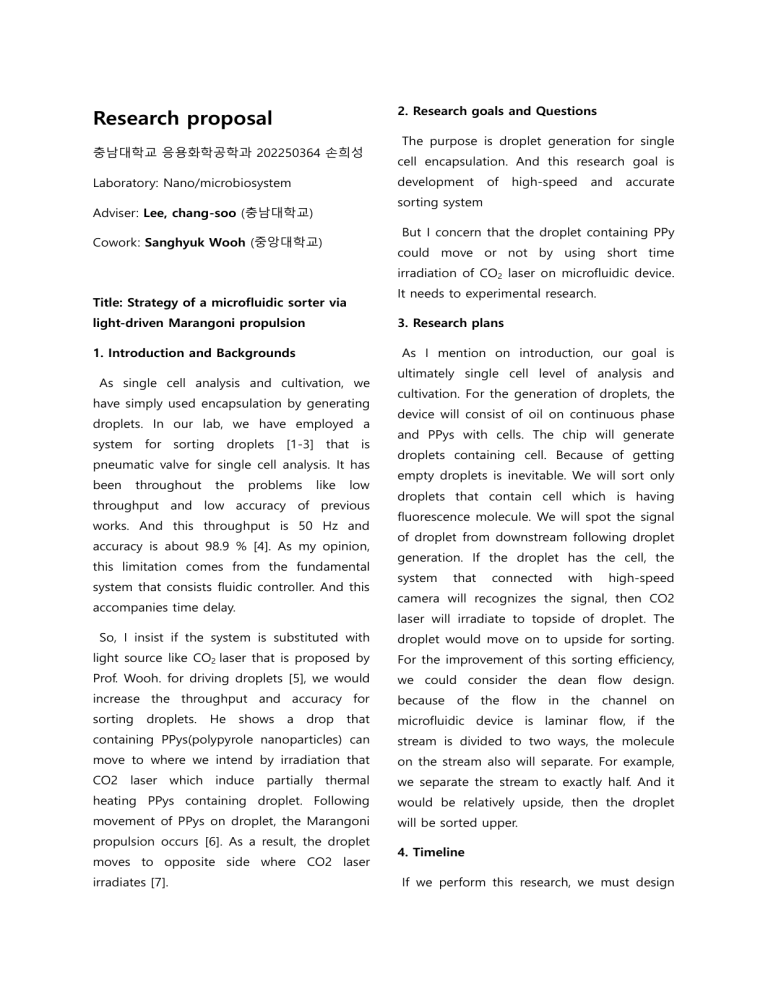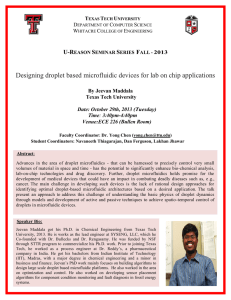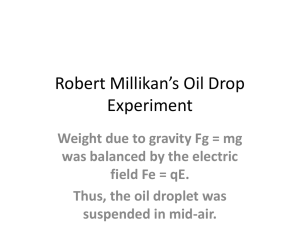
2. Research goals and Questions Research proposal 충남대학교 응용화학공학과 202250364 손희성 The purpose is droplet generation for single cell encapsulation. And this research goal is development Laboratory: Nano/microbiosystem of high-speed and accurate sorting system Adviser: Lee, chang-soo (충남대학교) But I concern that the droplet containing PPy Cowork: Sanghyuk Wooh (중앙대학교) could move or not by using short time irradiation of CO2 laser on microfluidic device. It needs to experimental research. Title: Strategy of a microfluidic sorter via light-driven Marangoni propulsion 3. Research plans 1. Introduction and Backgrounds As I mention on introduction, our goal is As single cell analysis and cultivation, we have simply used encapsulation by generating droplets. In our lab, we have employed a system for sorting droplets [1-3] that is pneumatic valve for single cell analysis. It has been throughout the problems like low throughput and low accuracy of previous works. And this throughput is 50 Hz and accuracy is about 98.9 % [4]. As my opinion, this limitation comes from the fundamental system that consists fluidic controller. And this accompanies time delay. ultimately single cell level of analysis and cultivation. For the generation of droplets, the device will consist of oil on continuous phase and PPys with cells. The chip will generate droplets containing cell. Because of getting empty droplets is inevitable. We will sort only droplets that contain cell which is having fluorescence molecule. We will spot the signal of droplet from downstream following droplet generation. If the droplet has the cell, the system that connected with high-speed camera will recognizes the signal, then CO2 laser will irradiate to topside of droplet. The So, I insist if the system is substituted with droplet would move on to upside for sorting. light source like CO2 laser that is proposed by For the improvement of this sorting efficiency, Prof. Wooh. for driving droplets [5], we would we could consider the dean flow design. increase the throughput and accuracy for because of the flow in the channel on sorting droplets. He shows a drop that microfluidic device is laminar flow, if the containing PPys(polypyrole nanoparticles) can stream is divided to two ways, the molecule move to where we intend by irradiation that on the stream also will separate. For example, CO2 laser which induce partially thermal we separate the stream to exactly half. And it heating PPys containing droplet. Following would be relatively upside, then the droplet movement of PPys on droplet, the Marangoni will be sorted upper. propulsion occurs [6]. As a result, the droplet moves to opposite side where CO2 laser irradiates [7]. 4. Timeline If we perform this research, we must design the device and check the possibility of movement of droplet by irradiation time of CO2 laser. And for setting up automatic analysis, programming like the Labview must 8. Personnel This proposal is just for the report. But if there is possibility, we could collaborate for this. be designed for transferring signal from cell’s 9. Reference fluorescence signal to CO2 laser irradiation [1] Kim, C., et al. (2017). "Microfluidic synthesis of monodisperse pectin hydrogel microspheres based on in situ gelation and settling collection." Journal of Chemical Technology & Biotechnology 92(1): 201-209. going through computer. 5. Materials High-speed camera with microscopy, syringe pump, photoresist polydimethylsiloxane (SU8 3025) (PDMS) for and device fabrication. HFE 7500 oil and Picosurf for making emulsion droplets. phosphate buffered saline (PBS). 2-NBDG, a fluorescent analog of glucose, Fluorescein sodium salt, alginic acid, acetic acid, Optiprep. 6. Expected application In our lab, several researchers work on single cell cultivation of Escherichia coli, Staphylococcus aureus, etc. that expresses red or green fluorescent protein. We can test single cell encapsulation and sort by this method if applications, it works various out. As following experiments could perform like cell cultivation [8] and analysing cell to cell communication [9] or antimicrobial susceptibility testing [10]. 7. Budget Our lab already has most of set up for droplet sorter. But we would connect the CO2 irradiator. As I remember the prof. Wooh said we can buy commercial product which has beam of specific power. Totally we would buy the CO2 laser and composition for this. [2] Choi, C. H., Weitz, D. A., & Lee, C. S. (2013). One step formation of controllable complex emulsions: from functional particles to simultaneous encapsulation of hydrophilic and hydrophobic agents into desired position. Advanced materials, 25(18), 2536-2541. [3] Jang, S., Lee, B., Jeong, H. H., Jin, S. H., Jang, S., Kim, S. G., ... & Lee, C. S. (2016). On-chip analysis, indexing and screening for chemical producing bacteria in a microfluidic static droplet array. Lab on a Chip, 16(10), 1909-1916. [4] Jin, S. H., Lee, B., Kim, J. S., & Lee, C. S. (2021). Improvement strategy of a microfluidic sorter using a pneumatic bilayer valve. Chemical Engineering Science, 245, 116834. [5] Hwang, H., Papadopoulos, P., Fujii, S., & Wooh, S. (2022). Driving Droplets on Liquid Repellent Surfaces via Light‐Driven Marangoni Propulsion. Advanced Functional Materials, 32(15), 2111311. [6] a) M. Paven, H. Mayama, T. Sekido, H.-J. Butt, Y. Nakamura, S. Fujii, Adv. Funct. Mater. 2016, 26, 3199; b) H. Kawashima, M. Paven, H. Mayama, H.-J. Butt, Y. Nakamura, S. Fujii, ACS Appl. Mater. Interfaces 2017, 9, 33351; c) F. Li, M. A. Winnik, A. Matvienko, A. Mandelis, J. Mater. Chem. 2007, 17, 4309; d) K. M. Au, M. Chen, S. P. Armes, N. Zheng, Chem. Commun. 2013, 49, 10525. [7] Wooh, S., & Butt, H. J. (2017). A Photocatalytically Active Lubricant‐Impregnated Surface. Angewandte Chemie, 129(18), 5047-5051. [8] Jeong, H. H., Jin, S. H., Lee, B. J., Kim, T., & Lee, C. S. (2015). Microfluidic static droplet array for analyzing microbial communication on a population gradient. Lab on a Chip, 15(3), 889-899. [9] Jin, S. H., Lee, S. S., Lee, B., Jeong, S. G., Peter, M., & Lee, C. S. (2017). Programmable static droplet array for the analysis of cell–cell communication in a confined microenvironment. Analytical chemistry, 89(18), 9722-9729. [10] Kim, K. P., Kim, Y. G., Choi, C. H., Kim, H. E., Lee, S. H., Chang, W. S., & Lee, C. S. (2010). In situ monitoring of antibiotic susceptibility of bacterial biofilms in a microfluidic device. Lab on a Chip, 10(23), 3296-3299.




